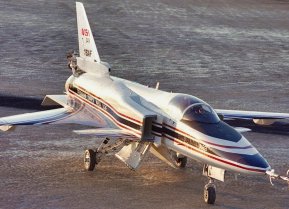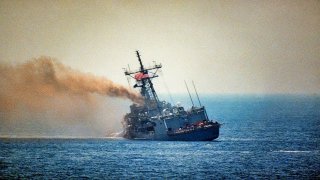USS Stark: How an Exocet Missile Nearly Sank a U.S. Navy Warship
Surviving personnel managed to keep USS Stark afloat and distress calls were answered by USS Waddell and USS Conyngham. According to the Pentagon, an Iranian helicopter also aided in the incident’s rescue operations
Decades have passed since an Iraqi jet carrying two Exocet missiles struck the Oliver Hazard Perry-class frigate USS Stark (FFG-31), killing thirty-seven U.S. Navy personnel and injuring nearly two dozen others.
Originally assumed to be an Iraqi Mirage fighter on a benign flight route, the long-range luxury business jet fired two missiles approximately 30 miles away from the ship around 10 minutes after first being detected. The Stark was equipped with search radar, electronic warfare support measures, and a close-in weapon system, however, they all failed to detect the incoming missiles. This incident remains a significant moment in history as it marks the only successful missile attack on a U.S. warship and the deadliest attack on a U.S. Navy ship since the Vietnam War.
Recounting the Strike on the USS Stark
Amidst the ongoing Iran-Iraq war, USS Stark was part of the Middle East Task Force assigned to patrol off the Saudi Arabian coast near the Iran-Iraq exclusion boundary. By 1987, Iran and Iraq were embroiled in their seventh year of warfare. At this time, a series of armed skirmishes between Iraq and Iran against merchant vessels dubbed the “Tanker Wars” plagued the Persian Gulf and Strait of Hormuz. The USS Stark was positioned outside the war zone to protect oil tankers traversing through the area.
When Stark detected the aircraft overhead, Captain Glenn R. Brindel sent a message to the pilot, believing it to be a Dassault Mirage F1 fighter. Brindel’s message read, "Unknown aircraft, this is U.S. Navy warship on your 078 (degrees) for twelve miles. Request you identify yourself." When the pilot did not respond, Brindel sent out a second message. No reply came. Within ten minutes of detecting the aircraft and sending out two messages, Stark was targeted by the jet’s radar.
Stark’s electronic surveillance systems and radar failed to detect the missiles, despite both being able to track the jet. According to reports, the Stark’s Tactical Action Officer attempted to increase the ship’s readiness level in the minutes before the first missile hit but was too late. Brad Peniston described the subsequent attacks in No Higher Honor. “The first missile punched through the hull near the port bridge wing, eight feet above the waterline. It bored a flaming hole through berthing spaces, the post office, and the ship’s store, spewing rocket propellant along its path. Burning at 3,500 degrees, the weapon ground to a halt in a corner of the chiefs’ quarters and failed to explode. The second missile, which hit five feet farther forward, detonated as designed. The fire burned for almost a day, incinerating the crew’s quarters, the radar room, and the combat information center.”
Attack Aftermath
Surviving personnel managed to keep USS Stark afloat and distress calls were answered by USS Waddell and USS Conyngham. According to the Pentagon, an Iranian helicopter also aided in the incident’s rescue operations. However, Iranian Prime Minister Mir Hossein Mousavi called the attack and the 37 deaths of U.S. sailors a “divine blessing” and urged the U.S. to leave the region. Initially, Iraq claimed Stark violated the war-zone boundaries and refused to take accountability. Ultimately, Iraq’s government admitted its fault and claimed the pilot assumed Stark was an Iranian ship.
About the Author
Maya Carlin is an analyst with the Center for Security Policy and a former Anna Sobol Levy Fellow at IDC Herzliya in Israel. She has by-lines in many publications, including The National Interest, Jerusalem Post, and Times of Israel.


